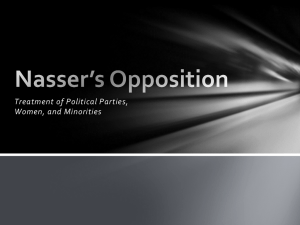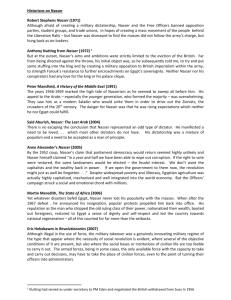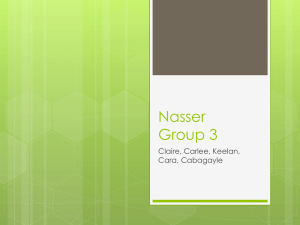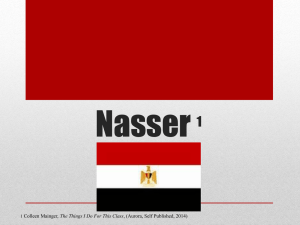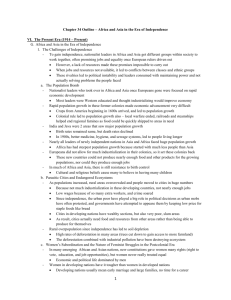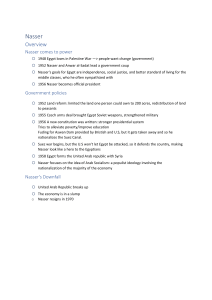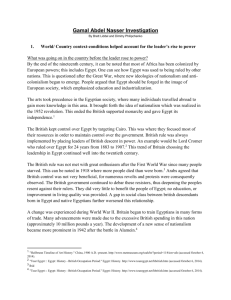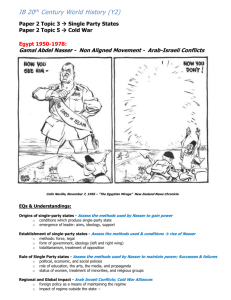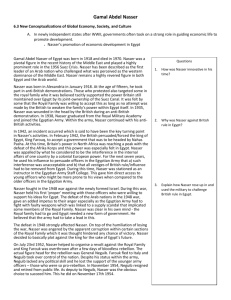Nasser and Egypt 2003
advertisement
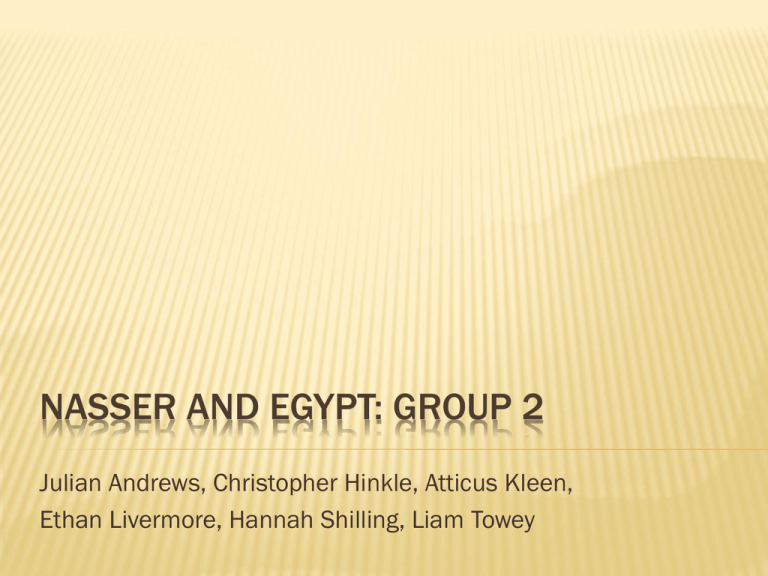
NASSER AND EGYPT: GROUP 2 Julian Andrews, Christopher Hinkle, Atticus Kleen, Ethan Livermore, Hannah Shilling, Liam Towey THE COUP OF 1952 Photo courtesy of Associated Press THE COUP OF 1952 Free officers movement. Lead by Muhammad Naguib and Gamal Abdel Nasser- The 25th of January became a very important date that took the name “Black Saturday” where hundreds of buildings were attacked and looted. In addition a couple Egyptians and Europeans died in these attacks. This was when the king started to get uneasy about who was supporting him. The king dismissed the Free Officers as “a bunch of pimps” (Pearson, 222) THE COUP OF 1952 Kingdom of Egypt. Lead by King Farouk- The United Kingdom backed the Kingdom of Egypt because they wanted to keep control of Egypt. The United States and the Soviet Union promoted the revolution and promoted the Free Officers because Britain's rule over Egypt was corrupt. Britain tried to create the Middle eastern version of NATO called the MEDO (Middle East Defence Organization) the Egyptian government just saw it as a ploy for foreign powers to establish themselves in the Canal Zone (Pearson, 222) DOMESTIC POLICIES UP TO 1955 Economic Change– Land Reform Land reform was seen as crucial to “improve Egypt’s impoverished, agrarian economy”. 73% of the population relied on farming. Land “shortage” was a significant issue. Attempts in the 1940’s to reform land ownership had largely failed because of the King’s objections. While only a handful of families had land taken from them, and only 10% of cultivable land was redistributed, the importance lied in the symbolic act by the Free Officers (Pearson, 225). DOMESTIC POLICIES UP TO 1955 The Liberation Rally The Liberation Rally: The Wafd Party, Muslim Brotherhood, and the communists were the most popular political parties in country. By 1953, all of the political parties but not the Muslim Brotherhood, independent trade unions, and student political groups were abolished. To replace them, the Liberation Rally was created to be a mass movement of the people. Nasser was the Secretary General of the Liberation Rally and said that the Rally would bring unity, discipline and work. It helped Nasser to have a strong position to get to power (Pearson, 226). DOMESTIC POLICIES UP TO 1955 The Philosophy of Revolution Nasser believed in political freedom. He thought the military should only “lead the way” in a nation but not lead. His main goal was achieving economic and social change, and he wrote a manifesto The Philosophy of Revolution in 1953. Published in 1954, it described how reform was difficult and outlined how over many years he planned to change Egypt’s system. (Pearson, 226). GAMAL ABDEL NASSER Photo courtesy of http://en.wikipedia.org/wiki/File:Nasser.jpg NASSER’S STEPS TO POWER Step 1- Naguib is undermined Naguib wanted some things that Nasser didn’t such as: a return to parliamentary democracy, better relations with the Muslim brotherhood, end to military rule (Pearson, 227). Feb 1954: Naguib attempts to step down b/c he lost support from the RCC (Pearson, 227). Naguib re-instated as the president, but with Nasser as the prime minister (Pearson, 228). NASSER’S STEPS TO POWER Step 2- Popular unrest is used to call for change Nasser makes speech pledging to restore parliamentary government by July 1954. Made numerous promises during that speech (Pearson, 228). Caused problems and unrest among many sections of Egyptian population because people feared that democracy would lead to the return of pre-revolutionary social and political elites (Pearson, 228). Nasser used his position to organize strikes and demonstrations for the revolution supported by peasants and city workers who wanted strong governments (Pearson, 228). NASSER’S STEPS TO POWER Step 3- Response to attempted assassination October 1954- Muslim brotherhood tries to kill Nasser (Pearson, 228). 700 Muslim brothers are arrested, 8 sentenced to death and six of them executed with much cruelty (Pearson, 228). Naguib is removed after the Muslim brotherhood attempted to kill Nasser. Step 4- The Presidency In January 1955, Nasser appointed presidency by RCC
